It is likely that changes are ahead for the AC Milan attacking lineup.
At the time of writing, Olivier Giroud has yet to sign a contract extension at the San Siro, with his current deal set to expire in the summer.
Despite his age, the former Arsenal forward could still have a lot to offer his side.
It is hard to argue with that sentiment, given his experience and, especially considering he is Stefano Pioli’s current top goalscorer, regularly leading the attacking lineup for the Rossoneri.
However, at 37 years of age, the fact of the matter is that he won’t be around forever.
This tactical analysis and scout report will assess Giroud’s role at the San Siro and how he fits into the Milan tactics.
We will also provide an analysis of Milan’s other current options, including Luka Jović and the younger crop of players.
Furthermore, we will use xGold to decipher if there are any viable forward options that could interest Milan in the transfer market.
Giroud leading the line
Pioli typically sets up his side in a 4-3-3 formation in which the wider of the front three, Rafael Leão and Christian Pulisic, operate near the touchlines on either flank.
This positioning gives the more advanced of the midfield three space to roam forward to support Giroud in the attacking phases.
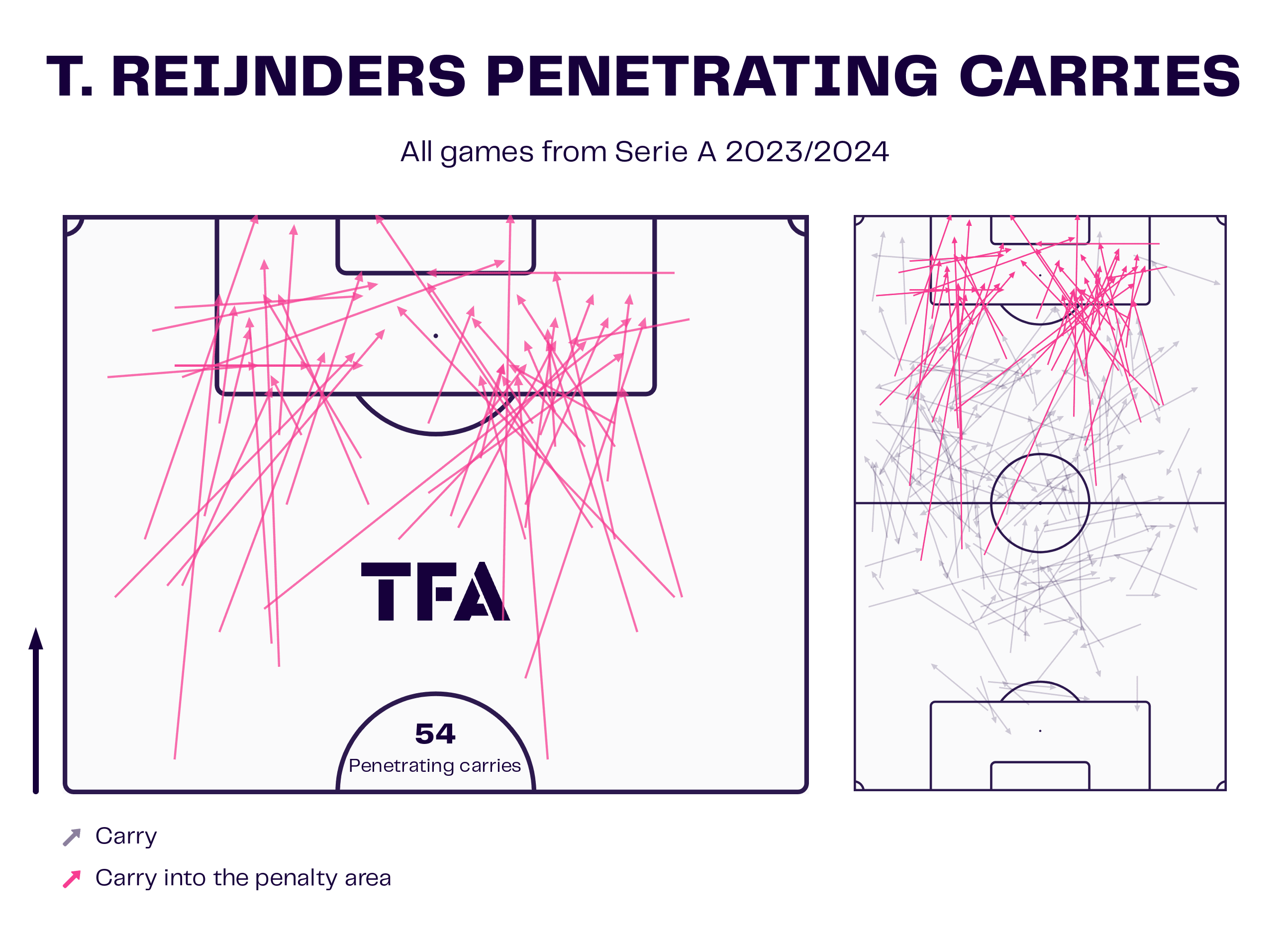
The graphic exemplifies this with the positive carries that Tijjani Reijnders makes from the midfield.
Reijnders is strong at carrying possession into the area, and it is noticeable that he often begins his carries either just within the attacking half or the edge of the final third.
He is able to be so positive in possession because of Giroud.
Giroud is a crucial figure in the dialogue between the midfield and the attack, as his positional play enables Milan to progress.
The Frenchman will often drop deep within his own half, such as below, to draw an opposition defender out of position.
Milan then look to make runs to exploit this space.
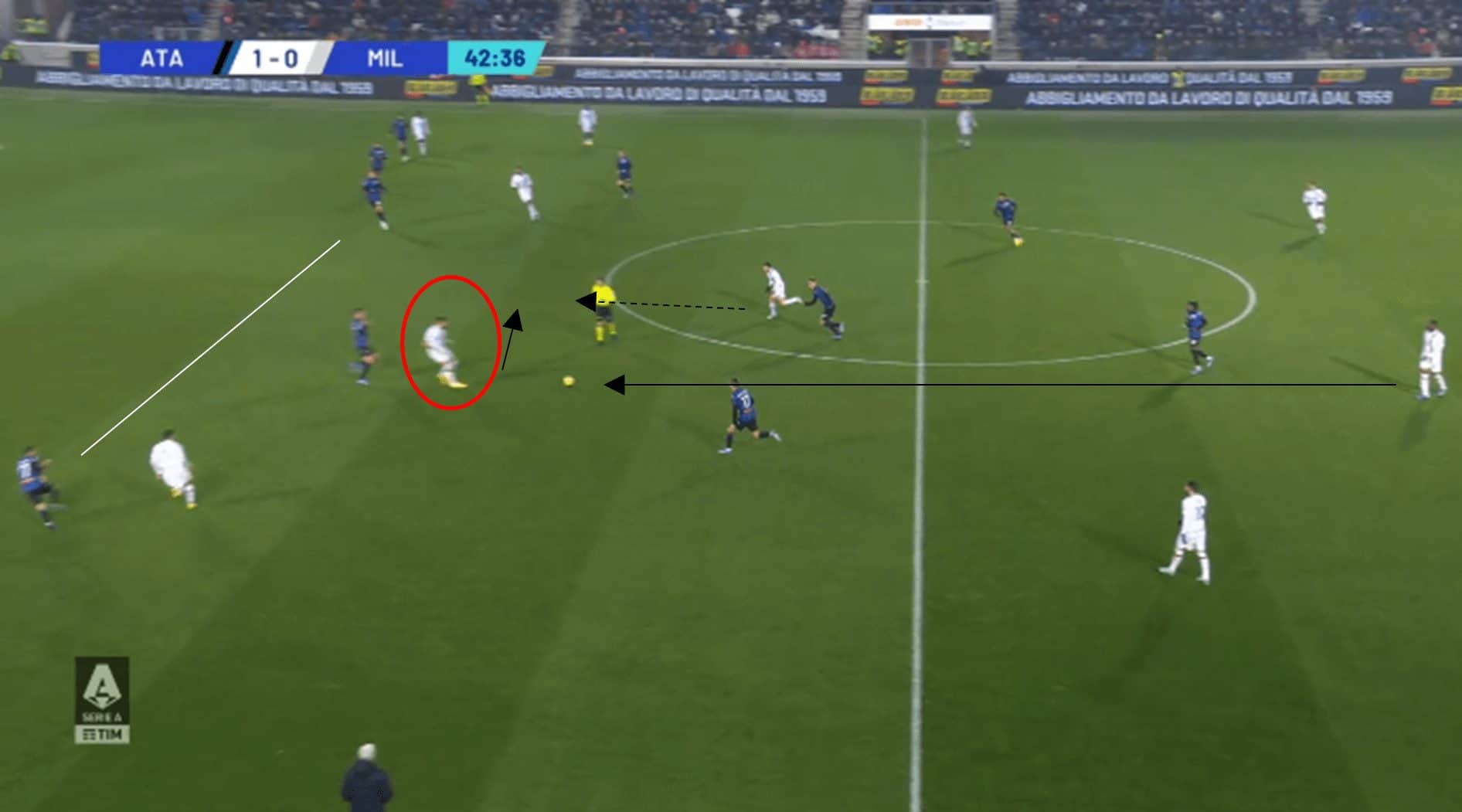
Upon receiving the ball, Giroud looks to either provide flick-ons, play one-two combinations with the advancing midfielder, or alternatively, switch play out to the wider options upfront.
Following on from such passing, the former Arsenal man looks to make runs into the penalty area to get on the end of crosses.
Once arriving in the penalty area, Giroud makes his presence known.
A particular strength of his is his aerial ability, as the majority of his goals in open play in Serie A this season have been headers.
Milan further tend to use his aerial ability to their advantage with long balls towards the forward line.
There is no doubt that he is an essential figure in Milan’s current attack, as only Inters Lautaro Martínez has scored more than Giroud in Italy’s top flight this campaign.
However, a weakness of Giroud’s is his lack of pace.
Consequently, he doesn’t look to sit on the shoulder of the opposition defence as the likelihood is that he will not be able to outpace his opponent.
Moreover, his lack of pace ensures he rarely carries the ball, leaving the responsibility to the wider of the front three.
Although this is a strength of Leão’s, Milan rank relatively mid-table in the league for their passes into the penalty area as well as into the final third.
There appears to be room for improvement up front.
Nevertheless, at the time of writing, the Rossoneri have scored 38 goals in Serie A this season, bettered only by rivals Inter.
This goal tally, as well as their expected goal tally of 30.1 for the season, suggest there is strength to Milan’s attacking play.
Arguably, the best is still yet to come from some of the current attacking options, considering Leão and Pulisić, who, at 24 and 25 years of age, are both approaching their prime years.
The sticking point that remains, though, is who could replace Giroud.
Has Luka Jović done enough for a new deal?
Once heralded as one of football’s exciting young prospects, Jović’s career hasn’t quite lived up to expectations.
The Serbian forward hit a rich vein of form back in the 2018-19 season whilst on loan at Eintracht Frankfurt, scoring 17 goals in the equivalent of 24.9 90s.
This caught the attention of Real Madrid.
However, he struggled for game time in the Spanish capital.
He eventually left the Spanish giants last season for Fiorentina, but he only managed six goals in 31 appearances.
Jović signed a one-year deal at Milan during the summer and has made 5.1 90 appearances in Serie A so far, scoring three goals.
The Serbian’s style of play is reminiscent of Giroud, as he too looks to drop deeper to aid attacking movements.
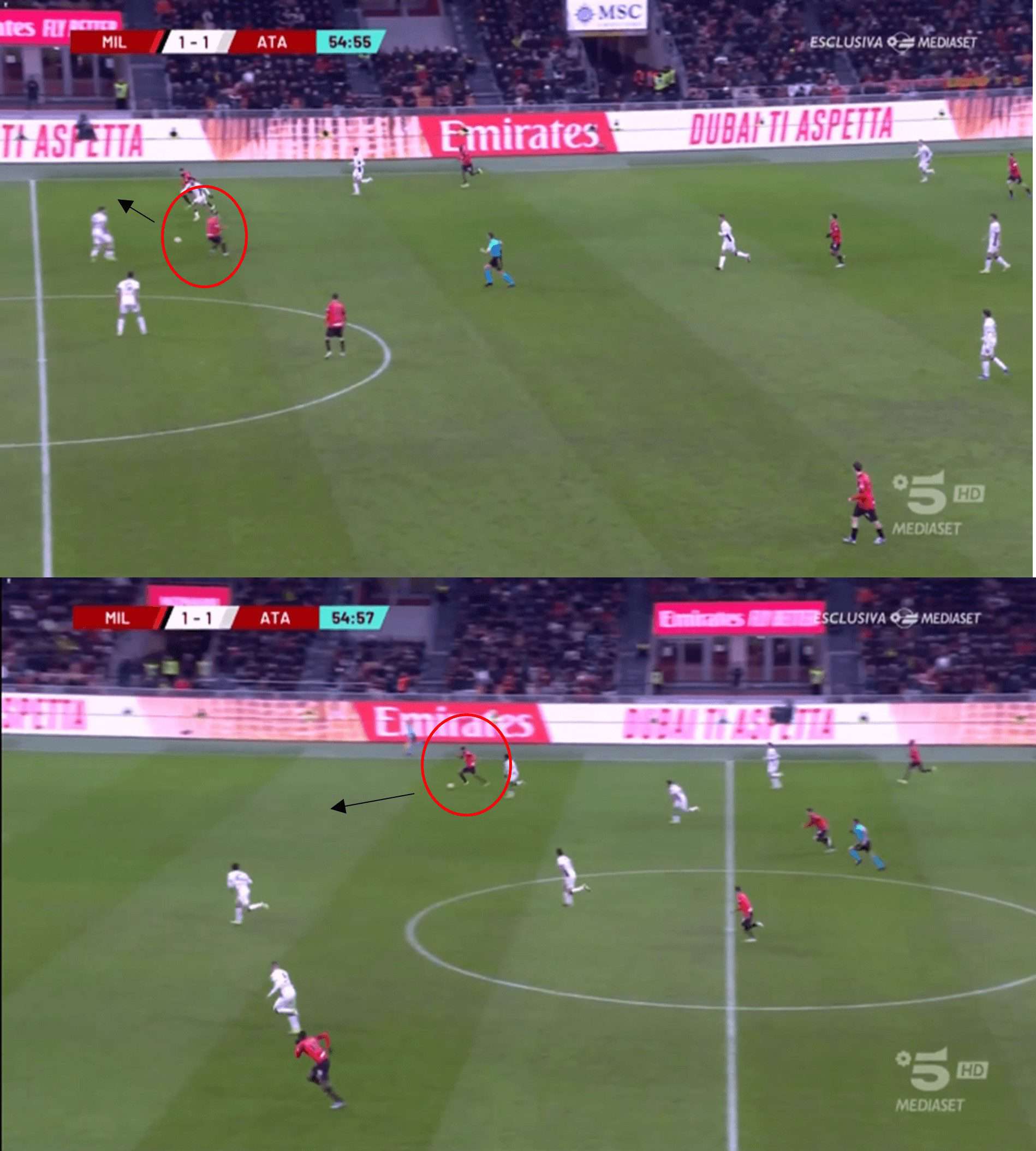
Jović’s first-time flick towards Ruben Loftus-Cheek allows a swift attacking move.
Moreover, Jović has successfully drawn out the opposition defender, allowing his teammate to run into the vacant space.
In further parallels to the Frenchman, he has a strong aerial presence and ranks in the top 5% of centre forwards in tier one for percentage of aerial duels won this season.
This demonstrates that he, like Giroud, is a viable option for long balls played toward the front line.
At 26 years of age, Jović is heading into his prime years and, unsurprisingly, is quicker with off-the-ball movements in comparison to his older teammate.
A further advantage for Milan with regard to Jović is his willingness to retreat into his own half for defensive duties.
Jović currently ranks in the 88th percentile for percentage of defensive duels won compared to other tier-one centre forwards.
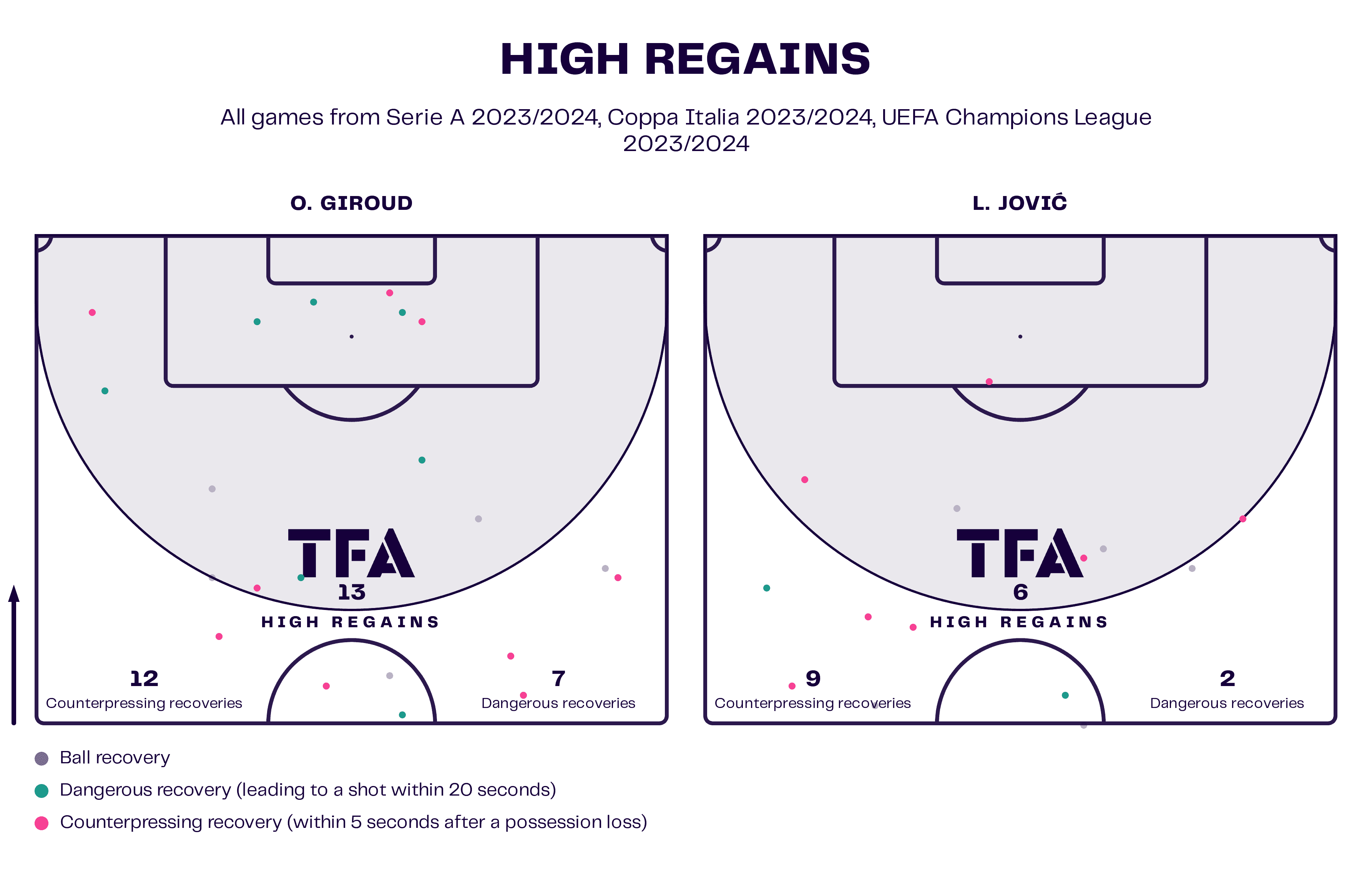
The above graphic shows neither of the two current forward options at Milan shirk from high pressing.
Considering Jović has had much less game time, the fact he has completed only three fewer counterpressing recoveries in all competitions suggests his aggressive nature upon losing possession as he will instantly look to regain the ball for his side.
However, it is noticeable from the graphic of the difference in the high regain positioning between the two forwards.
Jović will look to engage in a press closer to the halfway line, which does have its merits as it can prevent the opposition from advancing a dangerous attack.
On the other hand, Giroud’s press is much more successful in a potentially rewarding position for Milan.
It is shown that Giroud regains possession in the penalty area, where the expected goal value is likely to be higher.
Therefore, his defensive duties resulted in a stronger attacking outlet for Pioli’s side.
Whilst Jović can add value to the team defensively, undoubtedly, his true judgement will be in his scoring ability, and a look at the statistics makes for some interesting comparisons to Giroud.
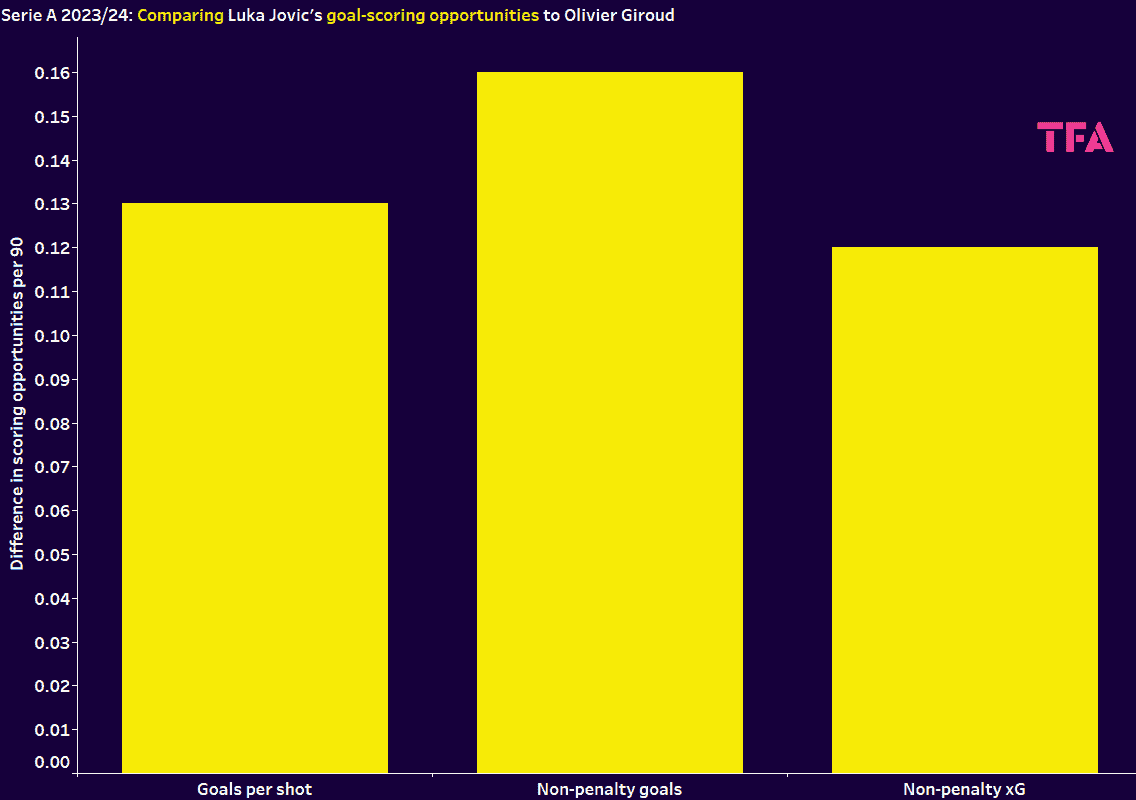
Despite Giroud being one of the top goalscorers in Serie A at present, four of his 10 goals have been from the penalty spot.
The graph shows that Jović has a higher goal-per-shot rate, non-penalty goals-per-90 rate, and non-penalty expected goals per 90 than his French counterpart this season.
Jović has a shot-on-target percentage of 66.7%, the highest in Serie A; 33% of his shots have resulted in a goal, ensuring he ranks joint top for this statistic.
This highlights how efficient the former Madrid player has been this season and how vastly improved he has been from his time at Fiorentina, where 33.9% of his shots hit the target, and only 11% of his efforts resulted in a goal.
Jović’s non-penalty expected goal figure of 0.44 per 90 is higher than Giroud’s 0.32 per 90.
This suggests Jović has been able to get into better-attacking positions than his teammate this campaign.
While this bodes well for Jović in terms of a new deal, it is also important to consider when he is scoring his goals as if a player were to score more coming on as a substitute when their side is already three goals up; there is less intensity to the match than say if a game is tightly balanced throughout.
The majority of Giroud’s goals have led to Milan taking the lead, demonstrating his importance in the ability of the Italian side to take the threshold in games.
Of the five goals Jović has scored in all competitions this season, two have ensured Milan have taken the lead, and two have been to equalise for his side.
Ideally, Jović would have played more minutes this season in order to present a fairer comparison to Giroud.
However, the evidence points to the Serb being an important player at Milan who can influence games.
If he were to extend his deal, there appears to be scope for the former Madrid forward to get his career back on track at the San Siro.
To promote or purchase?
There are advantages to rewarding Jović with a new deal, but Milan may need to aim higher.
They currently sit third and although this is respectable, they are lagging in the title race.
If they are to become serious title contenders next season, it may be wise to look into their options in the transfer market.
We have used xGold to determine a centre forward between the ages of 26 and 27 from tier one and selected tier two leagues who could be a good fit at the San Siro.
Our research identified Ivan Toney as well as Ollie Watkins.
However, both players are believed to warrant high price tags.
Another player who made our top 10 list of contenders was Stuttgart’s Serhou Guirassy.
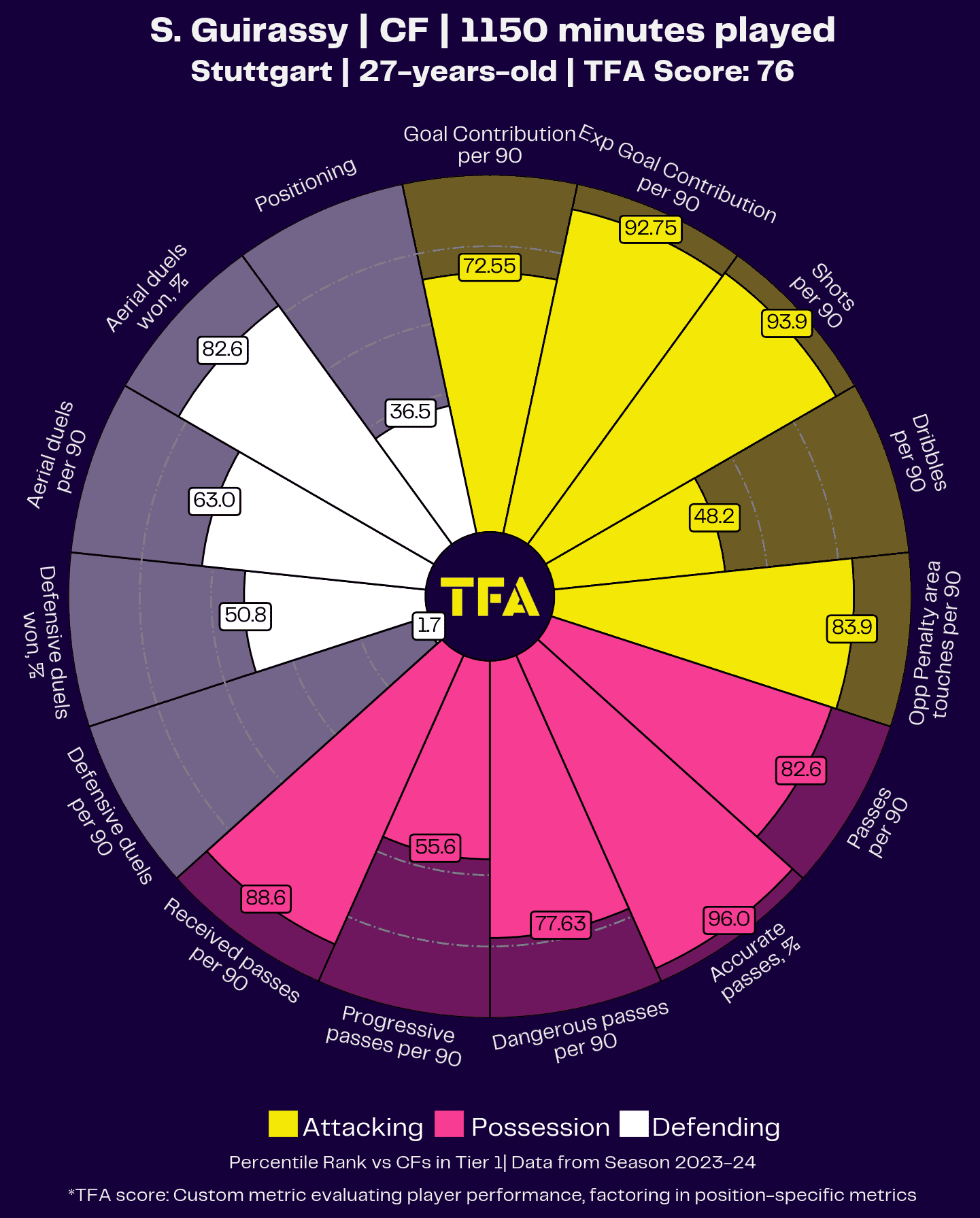
The pizza chart testifies to the exceptional season that Guirassy is enjoying at present.
Notably, he ranks highly for attacking credentials for a striker, but he also possesses attributes desirable for the Milan setup.
Like Giroud, Guirassy tends to drop deep to link up with the midfield and is a threat in the air.
The 27-year-old is also comfortable in possession, being a tricky opponent to force off the ball.
He is more skilful than what could be expected, given his tall stature.
However, a key difference at present is that Guirassy plays within a 4-2-3-1 system, linking up with the number 10 role.
Whilst Stuttgart are adopting a different formation to Milan’s preferred choice, Pioli’s side has been known to be flexible and has utilised the 4-2-3-1, with Loftus-Cheek occupying the space behind the striker.
There is undoubtedly scope for Guirassy to be incorporated at the San Siro, and it is certainly worth Milan’s while to at least enquire about the striker, whose goals per match rate of 1.45 per 90 exceeds Harry Kane.
Moreover, if Guirassy’s reported £15 million release clause is correct, he could be available for a bargain fee.
The trouble is, though, that given his credentials, he will be on the radar of most clubs across the continent.
Milan may have to look at fast-tracking their more youthful players as an alternative option.
Credit to Milan, as they have given minutes to some of the younger members of their squad this season.
One such player is Noah Okafor, who has featured for slightly fewer minutes than Jović in the league this campaign but matches the Serb’s credentials for shots on target percentage and goals per shot.
Okafor is also slightly bettering his teammate for non-penalty expected goals per game, at 0.45 per 90.
It is encouraging for the Milan faithful that the 23-year-old has strong positional awareness, as he has the ability to find himself in just the correct position in the penalty area to create goal-scoring opportunities.
This is evidenced in the image below, as he hangs back for the cutback to score.
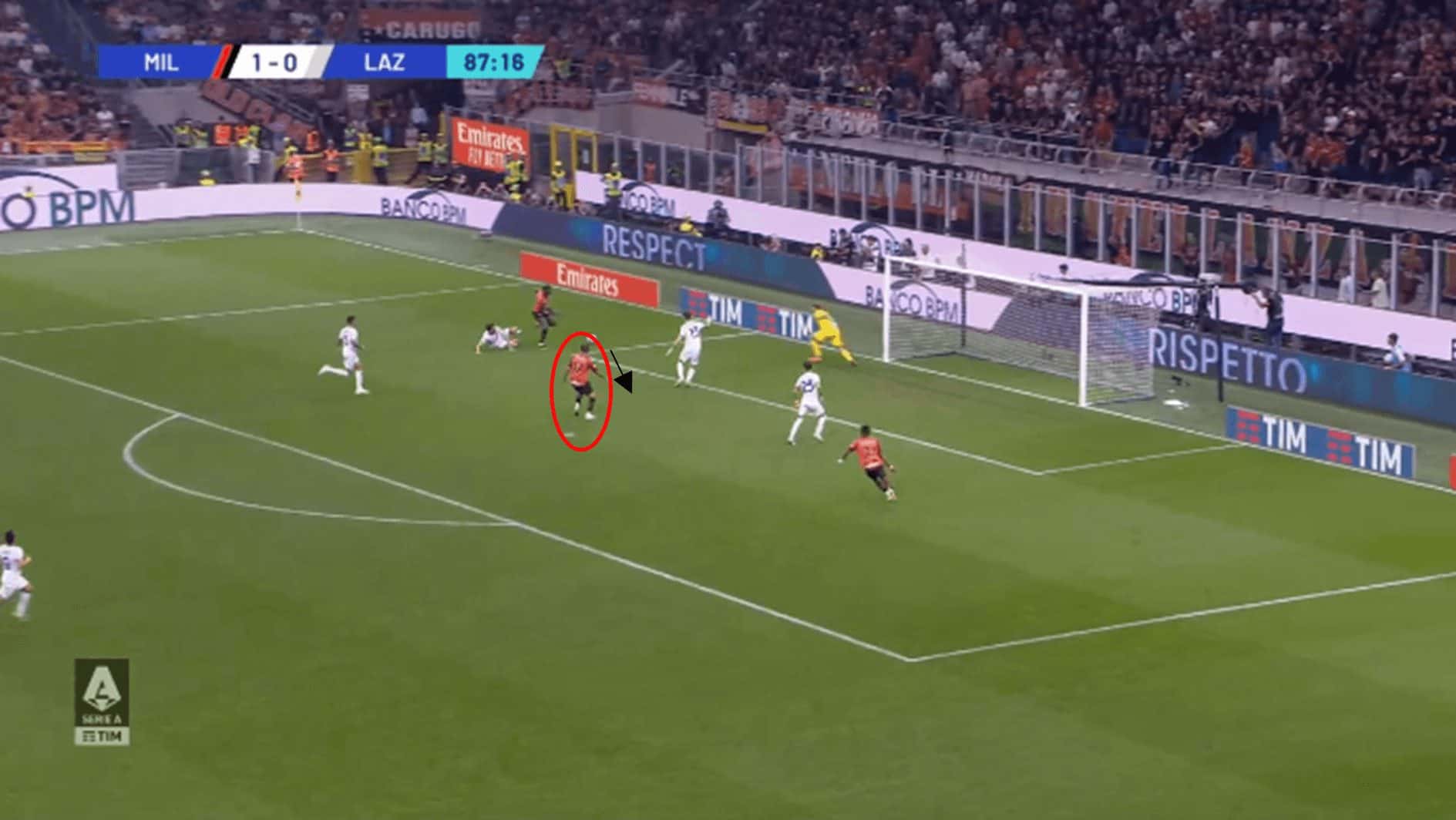
As well as his poaching ability in the centre forward position, he is versatile, having been known to occupy the left of a front three.
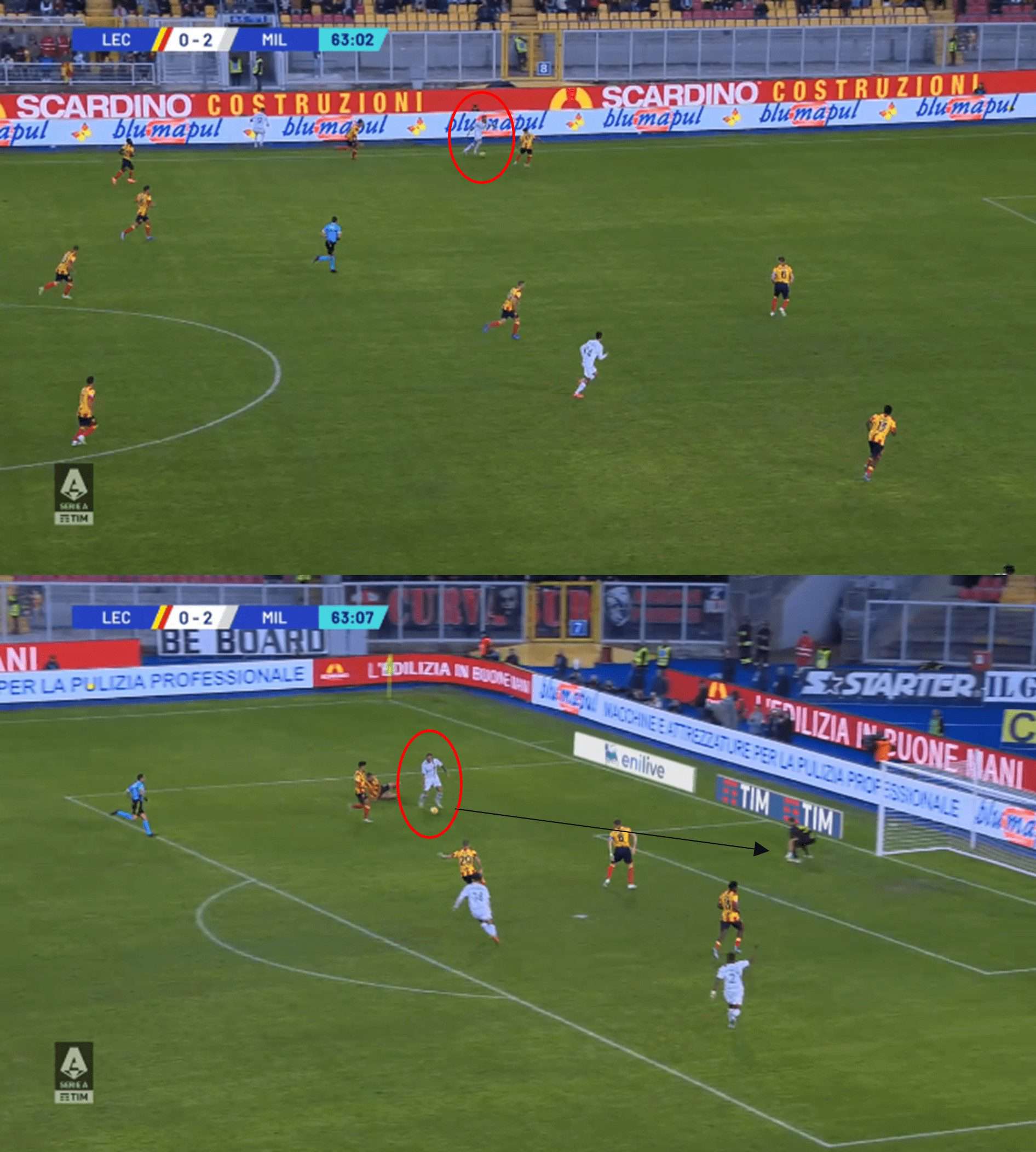
Okafor receives the ball out wide by the touchline and is able to take on the defender as well as outmuscle his opponents to get a shot on target.
This example highlights a strength of the Swiss: dribbling.
He currently ranks in the 91st percentile for dribbles per 90 among tier-one centre forwards.
He would certainly give the Milan forward line an extra dimension, as he can carve out chances from seemingly nowhere.
The 23-year-old is not the only versatile forward at present at Pioli’s disposal.
Chaka Traorè can play anywhere along the front line and is similar to Leão as he is a strong ball carrier.
The 19-year-old has quick feet and is always looking to play on the front foot, whether in or out of possession.
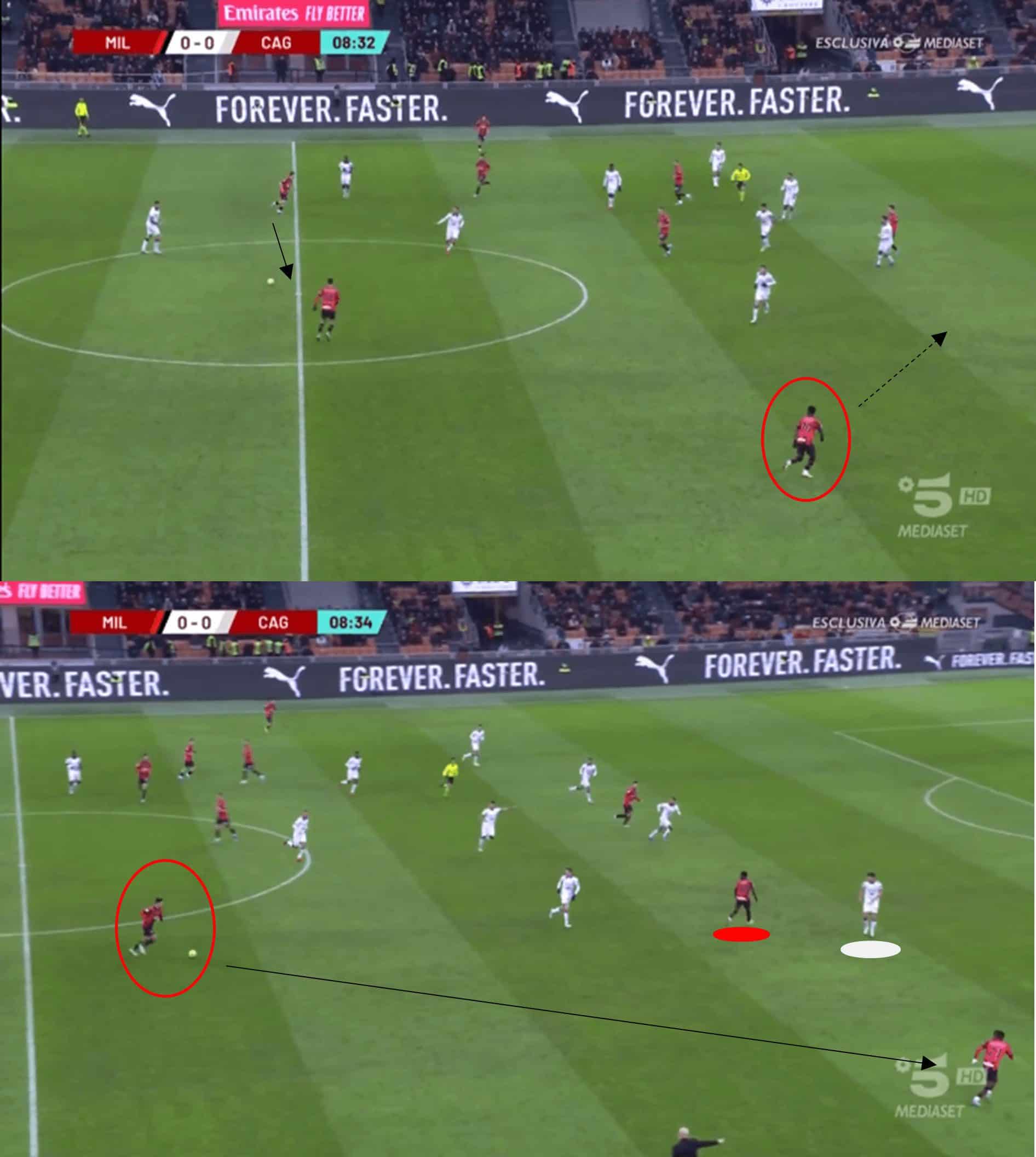
In the above example, Traorè is always alert when Milan have possession, and as soon as the ball is played across, he accelerates toward the centre of the forward line.
His off-the-ball movement leaves the left-sided defender caught between two Milan players, forcing him to track Traorè’s movement.
This enables Milan to exploit the space on the right channel.
The opposition has to be wary of not only Traorè’s intelligent runs but also his speed.
His pace facilitates dangerous counterattacking play, which poses a different attacking option for the Serie A side.
Another forward option is, of course, 15-year-old Francesco Camarda.
Considering his age, he is in the current first-team setup, which speaks volumes for his potential.
Camarda has continued to impress at youth level, scoring a staggering 483 goals for the Rossoneri.
Such unbelievable scoring statistics mean he is certainly one to watch for the future, but he has also managed to get some game time this season.
Camarda is strong for his age and can hack the intensity of playing with much older professionals.
Milan will be keen to manage his playing time, though, so he would not be expected to be the immediate answer to Giroud’s eventual retirement.
Nevertheless, the future of Milan’s attack looks bright.
Conclusion
In this tactical analysis and scout report, we have highlighted the importance of Giroud to Milan’s attacking play and identified how Jović has, given the opportunity, been just as adept in the role.
The evidence has pointed to Jović, at the very least, being worthy of a contract extension, as he is proving beneficial to the current squad.
Alternatively, Guirassy would be an ideal signing for the front three; looking ahead, Milan appear to have a wealth of younger players on their books who can offer different qualities to the current setup.
There could be some exciting times ahead for the red half of Milan.

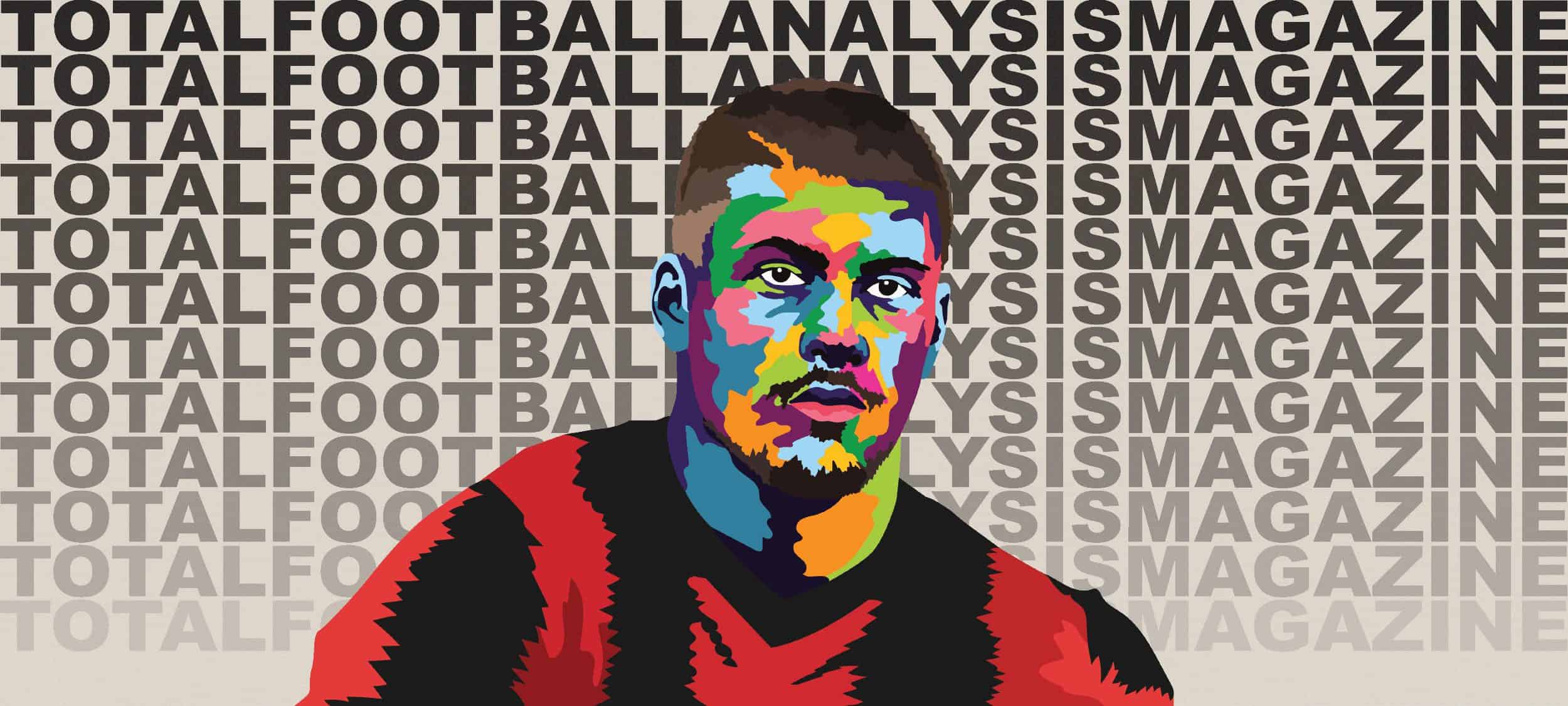




Comments